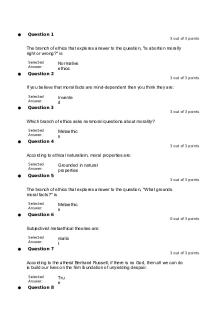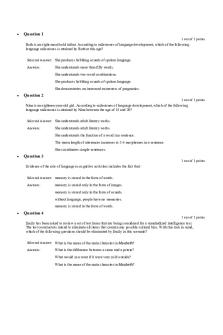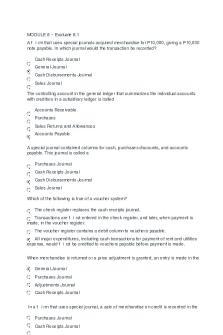Renal (8) Quiz PDF

| Title | Renal (8) Quiz |
|---|---|
| Author | Anonymous User |
| Course | Human Anatomy and Physiology |
| Institution | University of Technology Sydney |
| Pages | 7 |
| File Size | 100.4 KB |
| File Type | |
| Total Downloads | 79 |
| Total Views | 127 |
Summary
Practice Questions...
Description
Eight post lecture Quiz 16) Urine is transported from kidney to the urinary bladder by the: A) urethra. B) ureter. C) aorta. D) inferior vena cava 17) The functional units of the kidneys are: A) renal pyramids. B) renal sinuses. C) nephrons. D) glomeruli. 18) Erythropoietin is produced by the kidneys to: A) regulate removal of metabolic wastes. B) regulate red blood cell production by the bone marrow. C) conserve or eliminate hydrogen and bicarbonate ions. D) regulate blood solute concentration.
19) In which kidney region are the renal pyramids located? A) renal medulla B) renal cortex C) renal pelvis D) renal sinus 20) A glomerulus is: A) attached to the collecting duct. B) a hairpin loop segment of the renal tubule. C) the source of erythropoietin. D) a set of capillaries within the renal corpuscle.
21) Identify the structure marked as "3."
A) collecting duct B) proximal tubule C) renal corpuscle D) distal tubule
22) What increases the permeability of the glomerulus by making the capillaries "leaky"? A) microvilli B) fenestrations C) desmosomes D) tight junctions 23) Filtrate traveling through the renal tubule travels from the thick ascending limb to the:
A) proximal tubule. B) thick descending limb of the nephron loop (loop of Henle). C) distal tubule. D) thin ascending limb of the nephron loop (loop of Henle). 24) The cells of the macula densa and the juxtaglomerular (JG) cells form the: A) renal corpuscle. B) filtration membrane. C) juxtaglomerular apparatus (JGA). D) nephron loop (loop of Henle).
25) What is NOT a true statement about the cortical nephrons? A) Cortical nephrons are wrapped by the vasa recta. B) Cortical nephrons are the most numerous type of nephron in the kidneys. C) Cortical nephrons have a short nephron loop (loop of Henle). D) The renal corpuscle of a cortical nephron sits in the renal cortex. 26) The process of filtration occurs at the: A) proximal tubule. B) renal corpuscle. C) distal tubule. D) collecting duct. 27) Which statement best describes the function of tubular reabsorption? A) Tubular reabsorption reclaims items from filtrate and returns them to the blood. B) Tubular reabsorption moves items from the peritubular capillary blood into the filtrate. C) Tubular reabsorption removes toxins from the blood that was not filtered. D) Tubular reabsorption moves blood plasma through the filtration membrane of the glomerular capillaries.
28) Fenestrated glomerular capillaries are typically impermeable to: A) amino acids.
B) glucose. C) albumin. D) nitrogenous wastes. 29) Determine the correct order of the structure of the filtration membrane from deep to superficial. A) basal lamina, podocytes, fenestrated glomerular capillary endothelial cells B) fenestrated glomerular capillary endothelial cells, basal lamina, podocytes C) podocytes, basal lamina, fenestrated glomerular capillary endothelial cells D) fenestrated glomerular capillary endothelial cells, podocytes, basal lamina 30) The main force that promotes filtration in a nephron is: A) colloid osmotic pressure (COP). B) glomerular colloid osmotic pressure (GCOP). C) glomerular hydrostatic pressure (GHP). D) capsular hydrostatic pressure (CHP). 31) Glomerular colloid osmotic pressure (GCOP) is created by: A) systemic blood pressure. B) filtrate in the capsular space C) fluids in the blood plasma. D proteins such as albumin in the blood. 32) What do the macula densa cells regulate in their role as part of the tubuloglomerular feedback loop? A) changes in blood pH B) changes in glomerular hydrostatic pressure (GHP) C) changes in the glomerular colloid osmotic pressure (GCOP) D) changes in renal clearance 33) Jasmine has high blood pressure and an increased glomerular filtration rate (GFR). How does the tubuloglomerular feedback mechanism restore normal pressure in her glomerulus? A) The juxtaglomerular (JG) cells decrease production of renin. B) The afferent arteriole vasodilates. C) The juxtaglomerular (JG) cells increase production of renin. D) The efferent arteriole constricts. 34) What effect does high blood pressure have on the glomerular filtration rate (GFR) in the absence of regulatory mechanisms?
A) GFR will increase. B) GFR will decrease. C) GFR will not change. D) GFR will decrease, then increase.
35) How does the afferent arteriole vessel diameter change in order to decrease glomerular hydrostatic pressure (GHP) and restore the glomerular filtration rate (GFR) to normal? A) The afferent arteriole has no effect on GHP and GFR. B) The afferent arteriole will vasodilate. C) The afferent arteriole will vasoconstrict. D) The afferent arteriole will vasoconstrict, then vasodilate. 36) The myogenic mechanism acts to restore glomerular filtration rate (GFR) by changing: A) tubular secretion of metabolic wastes. B) vessel diameter. C) blood pH. D) blood pressure. 37) What will NOT stimulate the renin-angiotensin-aldosterone system (RAAS)? A) an increase in systemic blood pressure B) sympathetic nervous system stimulation C) low glomerular hydrostatic pressure (GHP) D) stimulation from the macula densa cells 38) A drug that inhibits angiotensin-converting enzyme (ACE) may lead to: A) increased blood volume. B) increased secretion of aldosterone. C) decreased blood pressure. D) increased sodium reabsorption.
39) How does atrial natriuretic peptide (ANP) contribute to a decrease in blood volume and systemic blood pressure?
A) ANP constricts the afferent arteriole and dilates the efferent arteriole. B) ANP dilates the afferent arteriole and constricts the efferent arteriole. C) ANP dilates both the afferent and efferent arterioles. D) ANP constricts both the afferent and efferent arterioles....
Similar Free PDFs

Renal (8) Quiz
- 7 Pages

Quiz 8 - Quiz 8
- 4 Pages

Renal
- 10 Pages

Quiz 8 - Weekly Quiz
- 6 Pages

Quiz Chapter 8 - Quiz
- 6 Pages

Quiz-8 - QUIZ
- 22 Pages

Buslaw QUIZ 8 - Quiz
- 6 Pages

Chapter 8 quiz #8
- 3 Pages

Quiz 8 - Chapter 8 Quiz Solved.
- 2 Pages

Chapter 8 Quiz - Weekly Quiz
- 3 Pages

Acctg quiz 8 - Accounting quiz
- 2 Pages

Week 8 quiz - Week 8
- 19 Pages

Repaso Renal
- 23 Pages

Fórmulas renal
- 10 Pages

kolik renal
- 13 Pages
Popular Institutions
- Tinajero National High School - Annex
- Politeknik Caltex Riau
- Yokohama City University
- SGT University
- University of Al-Qadisiyah
- Divine Word College of Vigan
- Techniek College Rotterdam
- Universidade de Santiago
- Universiti Teknologi MARA Cawangan Johor Kampus Pasir Gudang
- Poltekkes Kemenkes Yogyakarta
- Baguio City National High School
- Colegio san marcos
- preparatoria uno
- Centro de Bachillerato Tecnológico Industrial y de Servicios No. 107
- Dalian Maritime University
- Quang Trung Secondary School
- Colegio Tecnológico en Informática
- Corporación Regional de Educación Superior
- Grupo CEDVA
- Dar Al Uloom University
- Centro de Estudios Preuniversitarios de la Universidad Nacional de Ingeniería
- 上智大学
- Aakash International School, Nuna Majara
- San Felipe Neri Catholic School
- Kang Chiao International School - New Taipei City
- Misamis Occidental National High School
- Institución Educativa Escuela Normal Juan Ladrilleros
- Kolehiyo ng Pantukan
- Batanes State College
- Instituto Continental
- Sekolah Menengah Kejuruan Kesehatan Kaltara (Tarakan)
- Colegio de La Inmaculada Concepcion - Cebu
